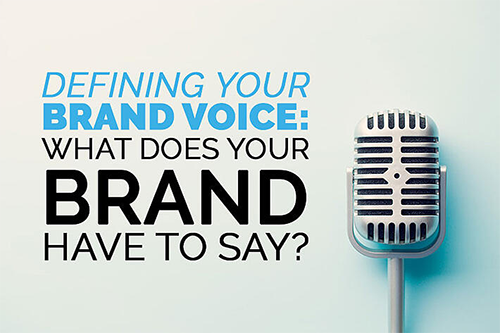When your customers and prospective clients communicate with your brand on any given channel, what do they hear and does it invoke a response?
A brand voice is how your company expresses itself using deliberate vocabulary, style and communication methods. As the essence of your business is consistently communicated through your selected voice, it’s important that voice is saying the right things. Expressing your brand personality in a way that makes people want to engage.
If you haven’t already, there is no better time than now to start identifying your brand’s defining characteristics, developing a tone of voice to embody them and applying it throughout your chosen visual marketing materials and channels.
5 Steps to Finding a Brand Voice to Match Your Company Personality
A brand voice may seem like a rather abstract concept, one that’s hard to capture. This can make it difficult to know where to start. The following steps can help you set in motion the process of defining your brand personality and crafting a voice to match.
1. Define your company’s why
The journey to effective communication starts with self-examination. A business’ first step is asking themselves, “Who are we? What do we stand for? And what key messages are we trying to tell the world?” You can’t be everything to everyone, and that’s not a bad thing. Be honest about your identity as a company.
Read: 3 Proactive Questions You Can Ask to Form Your Brand Identity
2. Choose words that capture your brand’s personality
The development process starts with identifying a few words that encapsulate your brand’s personality traits. These words likely can be siphoned from the answers you generated during your self-examination. A good way to approach this, according to Erika Heald with the Content Marketing Institute, is to pose this question to your team: “If your brand was a person, how would you describe its personality to someone?” Pick a handful of broad traits, and then further define each other.
3. Ask your employees for valuable input
No one person should be solely responsible for this creative process. For example, your employees are daily immersed in the culture of your company and regularly interacting with suppliers, contractors, customers and other important parties. Because of their insight, they can play a critical role in helping discover the right tone of voice for the brand.
4. Listen to your customers
Just as your employees supply an inside opinion, customers play the role of objective observers. They want something specific from your company, and you should care about that when cultivating the message and expression you plan to use. Pay attention to how customers interact with one another, both within your physical store or office and especially online. For better or worse, people feel comfortable being honest and also conversing with strangers through digital venues.
Read: 4 Secrets You Might Be Missing When Branding to Millennials
5. Write it down and apply it
Once you’ve narrowed down and solidified your voice, put it in writing. A chart – including your words, subwords, and definitions and some do’s and don’ts – is useful. Then, when you are working with new employees, freelancers or subcontractors, they have a clear, concise guide to help them develop content and materials that coexist seamlessly within your company’s ecosystem. The entire team can refer to what’s written down to ensure they are applying the right tone, no matter what channels they’re dealing with.
How Having a Voice Helps Your Brand
The No. 1 benefit of a brand voice is consistency. According to the Content Marketing Institute, by being consistent with the voice you are creating, you are “positioning yourself as an easily identified and authoritative source for your area of expertise.” Similarly, they add, consistency across tone and vocabulary “is essential to implementing localized content and intelligent content strategies effectively.”
By having a robust voice for your brand – one that is strident, vivid and clear – your customers can easily recognize and identify with you. You stand out in your own specific way and become an entity your consumers’ trust.
Brand Voices Heard Around the World
In a world awash with advertising and marketing, there is a lot of white noise. Some companies, however, are nailing it on the head when it comes to routinely applying a tone of voice that embodies their distinct personality. Here are three of the best:
- Coca-Cola
Coca-Cola is the powerhouse of the marketing world. The company’s consistent message of unity, coexistence and positivity can make even those who don’t like soda want to purchase a coke, just to “Taste the feeling.” Because of how steadily and smoothly they communicate their message, Coca-Cola has mastered the art of making a company appealingly genuine. - Denny’s
Denny’s has a marketing strategy that is enticing and relatable. The company’s tone of voice is whimsical, lively and outgoing – like the cool kid hosting the party. Their Twitter thread and Facebook wall are appropriately down-to-earth, considering the company’s mission and clientele, and entertaining to read. - Adult Swim
Adult Swim is not for everyone, but what makes the company sincere and trustworthy is that it doesn’t try to be. The company’s tone is eccentric, odd and targeted toward its specific audience. Those who enjoy the Adult Swim culture feel a sense of belonging and pleasure derived from engaging a like-minded, relatable entity.
Read: How to Tell If Your Brand Strategy is Working
Every person has a tone of voice. That’s what makes them genuine, interesting and individual. No matter what industry you work in, your company will thrive by being humanized and given its suitable tone of voice.
When consistently applied throughout your brick-and-mortar establishment, website and social media pages, and branding collateral, this voice will ensure your message is being effectively communicated, regardless of the messenger, recipient or mode of transfer.

